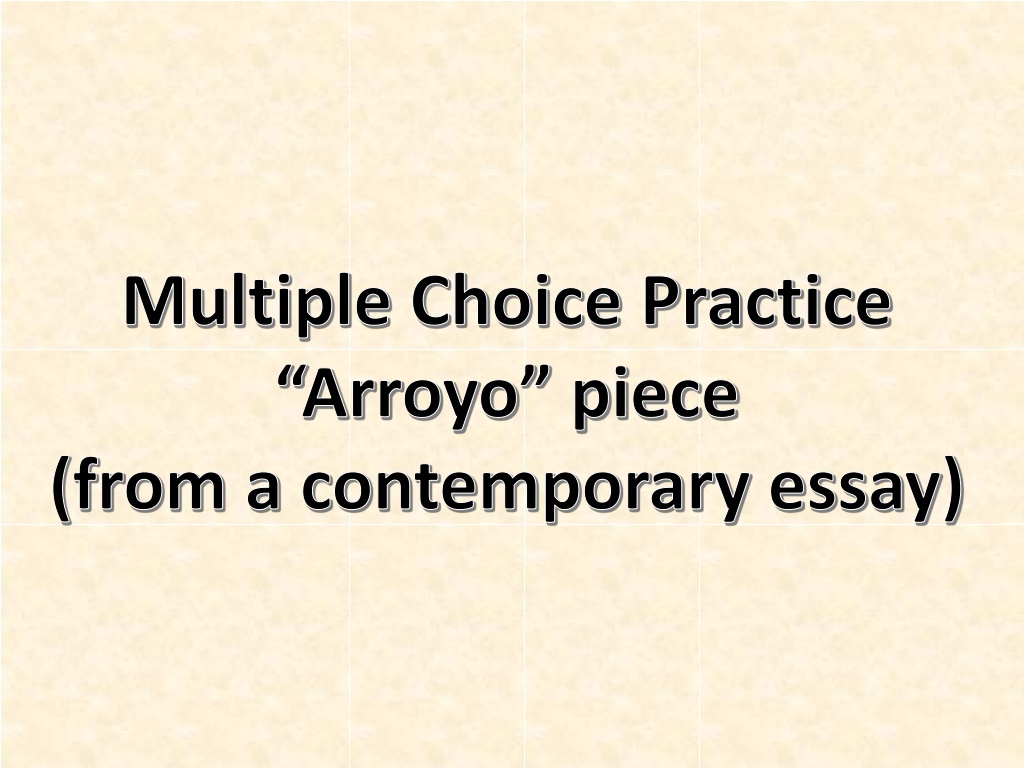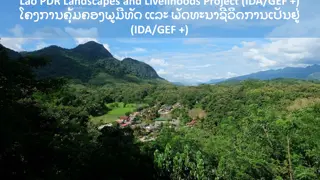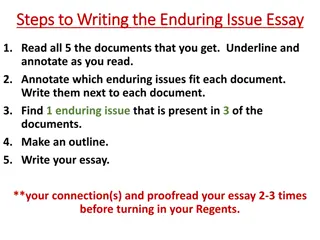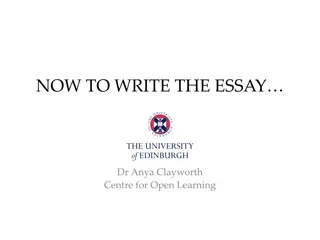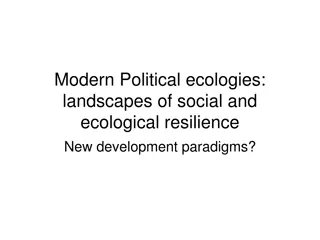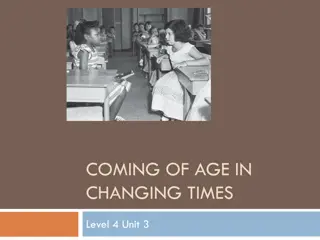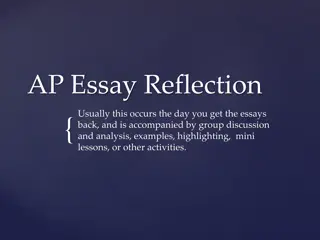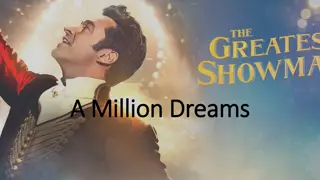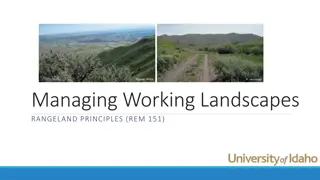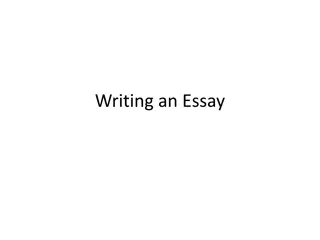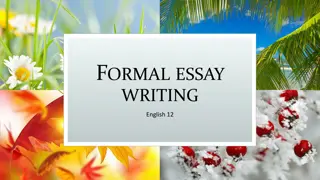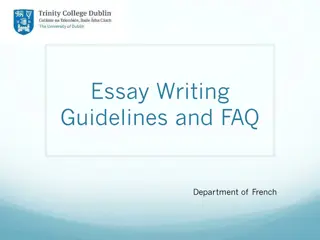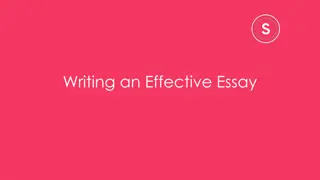Insights on Landscapes and Dreams: Contemporary Essay Analysis
The essay delves into the similarities between landscapes and dreams, highlighting their power to translate deep emotions into tangible images. It explores the communal nature of storytelling among the Laguna Pueblo people and the sense of shared experiences. Additionally, it examines the significance of repetitive phrases in emphasizing common human experiences and the link between personal and collective identity.
Download Presentation

Please find below an Image/Link to download the presentation.
The content on the website is provided AS IS for your information and personal use only. It may not be sold, licensed, or shared on other websites without obtaining consent from the author. Download presentation by click this link. If you encounter any issues during the download, it is possible that the publisher has removed the file from their server.
E N D
Presentation Transcript
Multiple Choice Practice Arroyo piece (from a contemporary essay)
Landscape thus has similarities with dreams. Both have the power to seize terrifying feelings and deep instincts and translate them into images visual, aural, tactile into the concrete where human beings may more readily confront and channel the terrifying instincts or powerful emotions into rituals and narratives which reassure the individual while reaffirming cherished values of the group. The identity of the individual as a part of the group and the greater Whole is strengthened, and the terror of facing the world alone is extinguished. C B E 29. The author argues that landscapes and dreams are similar in which of the following ways? (A) Both give visible shape to intangible emotions. (B) Both lend themselves to solitary contemplation. It isn t solitary; it s communal (C) Both serve to disturb or alter the status quo. No; it reaffirms cherished values of the group (D) Both have surprising and unforeseen contours. Never mentioned (E) Both reveal the insecurities of the person who experiences them.
Even now, the people at Laguna Pueblo spend the greater portion of social occasions recounting recent incidents or events which have occurred in 15 the Laguna area. Nearly always, the discussion will precipitate the retelling of older stories about similar incidents or other stories connected with a specific place. 30. The words Even now (line 12) and Nearly always (line 15) serve to (A) reveal the contradictory perspectives in Laguna Pueblo legends (B) stress the continuing place of legend in Laguna culture (C) attest to the factual basis of many legendary events It isn t abut fact vs. myth (D) concede that legends can play several distinct cultural roles Author isn t conceding; he/she is affirming (E) qualify the author s point that legends are relevant to modern human experience No; they confirm
You are never the first to suffer a grave loss or profound humiliation. You are never the first, and you understand that you will probably not be the last to commit or be victimized by a repugnant act. 31. Which of the following best describes the effect of the repetition of the word you in lines 31-35 ? (A) It disassociates the author from Laguna stories and rituals. Whole piece is about the communal (B) It emphasizes the consoling effects of Laguna stories for an individual. (C) It stresses the author s sympathy for the sufferings of the Lagunas. Misreading, as no sympathy is sought for any identified suffering (D) It contrasts with the intimate tone established earlier in the passage. Still intimate; invites reader to understand the commonality (E) It undermines statements about the commonality of certain experiences. It affirms, not undermines
others older or more experienced than you who suffered similar losses. The wide deep arroyo near the Kings Bar (located 40 across the reservation borderline) has over the years claimed many vehicles. 32. The shift from the second to the third paragraph represents a shift from (A) generalization to specific example (B) one universal observation to another No; the 3rd paragraph is specific (C) assertive to speculative writing A specific is offered; it s a recounting of an incident (D) a metaphorical flourish to a literal proposition No metaphor (E) a focused argument to a digression Not a digression; it makes sense in exemplifying the general concept from the previous paragraph
A few years ago, when a Vietnam veterans new red Volkswagen rolled backwards into the arroyo while he was inside buying a six-pack of beer, the story of his loss joined the lively and large collection of stories already connected with that big arroyo. 33. In lines 41-46 ( A few . . . arroyo ), the author cites the loss of the Vietnam veteran s car primarily to (A) point out the dangers of careless driving not the focus (B) exemplify the treatment of veterans of the Vietnam War Not the focus (C) demonstrate that loss of property is unimportant when compared with loss of life No life is lost (D) provide an example of a story that will be retold (E) warn others who might tempt fate in a similar way There is no precautionary tone and no one is tempting fate
But this man could not have felt any worse than the man who, some years before, had left his children and mother-in-law in his station wagon with the engine running. When he came out of the liquor store his station wagon was gone. He foundit and its passengers upside down in the big arroyo. Broken bones, cuts and bruises, and a total wreck of the car. 34. The story told in lines 50-57 ( But this . . .the car ) serves to (A) retell an ancient Laguna myth in contemporary terms Kind of accurate but not the BEST choice (B) convey the author s concern about the consequences of the Vietnam War Not ever mentioned (C) ironically highlight how awful the veteran s predicament really was Vet s experience is put in perspective not that bad (D) illustrate that the veteran s disaster was not just an individual, isolating experience (E) examine why the arroyo inspires fear and dread Misreading; shallow interpretation
35. The sentence in line 57 (The big arroyo has a wide mouth) uses which of the following? (A) Paradox (B) Satire (C) Personification (D) Contrast (E) Simile
36. The statement that the arroyos existence needs no explanation (line 58) resembles most closely the view of (A) the individual (line 9) contradicts the group/whole/communal aspect (B) children (line 20) They are still learning about the stories and how they relate (C) the Vietnam veteran (line 42) C and D serve as examples of why the arroyo needs no explanation (D) the man whose station wagon rolled into the arroyo (lines 50-57) (E) the old believers (line 67) They are the ones who ve heard/witnessed/passed along the stories, helping to create familiarity
I seldom drive past that wide deep arroyo without feeling a familiarity with and even a strange affection for this arroyo. Because as treacherous as it may be, the arroyo maintains a strong connection between human beings and the earth. The arroyo demands from us the caution and attention that constitute respect. It is this sort of respect the old believers have in mind when they tell us we must respect and love the earth. 37. The author feels a strange affection (line 62) for the arroyo primarily because it (A) is depicted as having human qualities in many Laguna legends (B) symbolizes how resilient the natural landscape can be when it is abused (C) is a place that has been familiar since childhood (D) attracts visitors who are interested in the Laguna area (E) generates stories and legends that connect the local inhabitants to the earth Note that the author puts him/herself in the area and employs 1st person collective POV
Paragraph 3: The wide deep arroyo near the Kings Bar (located across the reservation borderline) has over the years claimed many vehicles. A few years ago, when a Vietnam veteran s new red Volkswagen rolled backwards into the arroyo while he was inside buying a six-pack of beer, the story of his loss joined the lively and large collection of stories already connected with that big arroyo. I do not know whether the Vietnam veteran was consoled when he was told the stories about the other cars claimed by the ravenous arroyo. All his savings of combat pay had gone for the red Volkswagen. But this man could not have felt any worse than the man who, some years before, had left his children and mother-in-law in his station wagon with the engine running I seldom drive past that wide deep arroyo without feeling a familiarity with and even a strange affection for this arroyo 38. The author s devices of argument in the passage include which of the following? I. Reinforcing a case by including a personal perspective II. Providing a specific example to illustrate an abstract concept III. Citing the evidence of historical scholarship (A) I only (B) I and II only (C) I and III only (D) II and III only (E) I, II, and III
39. The author values storytelling because a storyteller has the power to (This is an inference question; you need to understand that the stories create a bond, a communal life experience) (A) give listeners the means to prioritize random events It s sharing, not prioritizing, and the events aren t random (B) remind listeners that most experiences have a happy outcome No, as evident by the Vet and the station wagon driver (C) help listeners to realize that their troubles are not unique (D) permit listeners to enjoy the pleasure of a suspenseful tale Purpose is not to entertain (E) answer questions answer questions that have previously baffled listeners Questions aren t posed
40. Taken as a whole, the passage is best described as (A) an implicit defense of a controversial idea (B) an expository piece relying chiefly on comparison and contrast (C) an explanatory account including historical and contemporary perspectives (D) a descriptive passage built on a sequence of mythic events (E) a satiric investigation and refutation of outdated beliefs
41. The author would be most likely to describe the legends of the people at Laguna Pueblo as which of the following? (A) A body of stories periodically refreshed by the addition of relevant new stories (B) A set of stories requiring frequent revision to reflect linguistic change (C) A series of fragile constructions, vulnerable to being forgotten and lost (D) Direct transcriptions of their storytellers most vivid dreams (E) Imaginative responses to unprecedented human victories and disappointments
